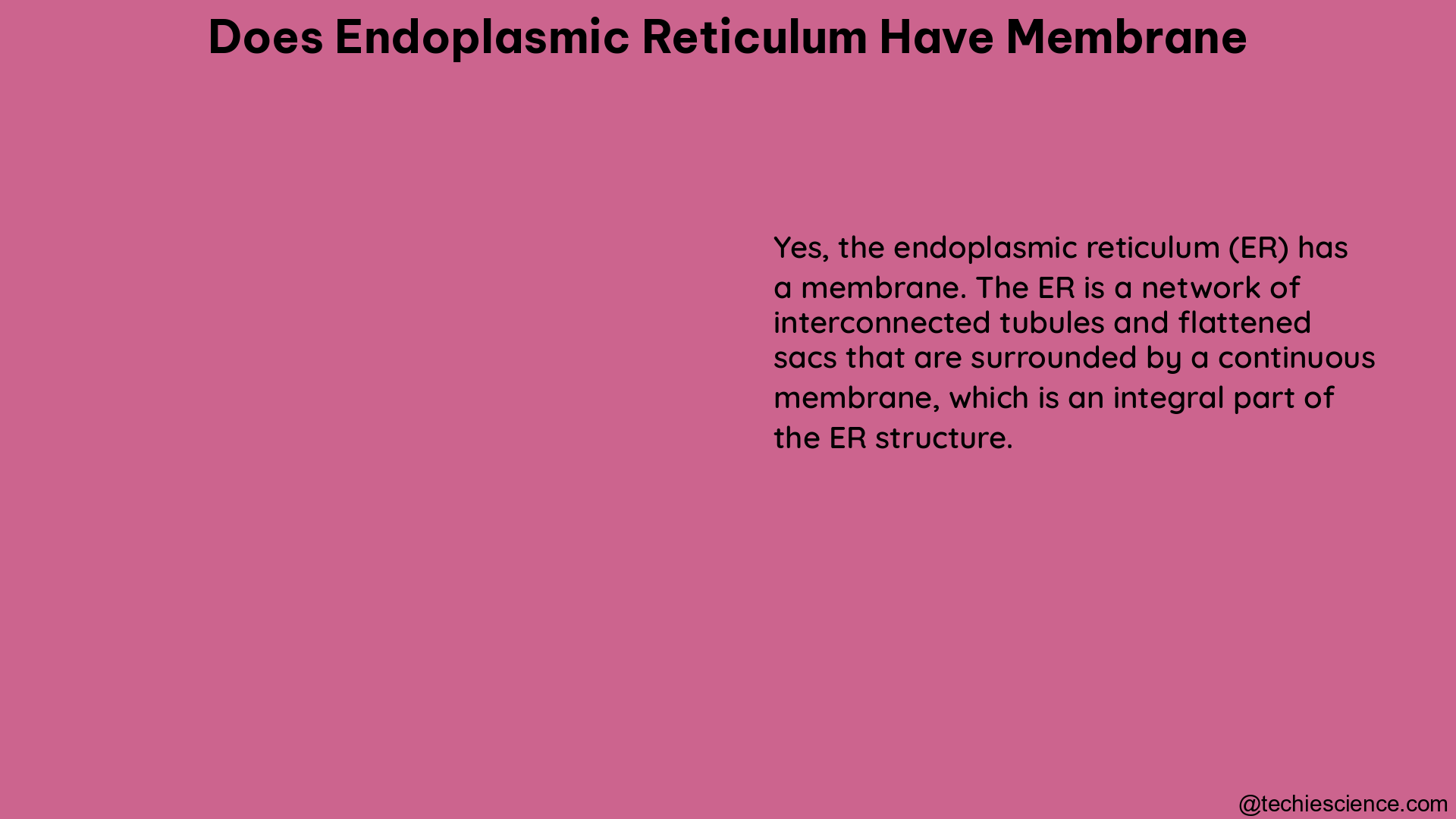The endoplasmic reticulum (ER) is a vast, interconnected network of membranous tubules and sacs that play a crucial role in various cellular processes. As evidenced by multiple sources, the ER is indeed a membrane-bound organelle, with a continuous, unbroken phospholipid bilayer forming its structure.
The Structure and Composition of the ER Membrane
The ER membrane is composed of a phospholipid bilayer, similar to the plasma membrane, but with a unique composition and properties. The ER membrane is enriched in specific lipids, such as phosphatidylcholine, phosphatidylethanolamine, and phosphatidylserine, which contribute to its unique fluidity and permeability characteristics.
In addition to the phospholipids, the ER membrane also contains a variety of integral and peripheral membrane proteins. These proteins serve various functions, including:
-
Protein Translocation and Folding: The ER membrane contains specialized protein complexes, such as the translocon, which facilitate the translocation of newly synthesized proteins into the ER lumen, where they undergo folding and post-translational modifications.
-
Lipid Biosynthesis: Enzymes involved in the synthesis of various lipids, such as phospholipids and sterols, are embedded within the ER membrane.
-
Calcium Regulation: The ER membrane contains calcium-binding proteins and calcium-transport channels that regulate the concentration of calcium within the ER lumen, which is crucial for various cellular processes.
-
Signaling Pathways: The ER membrane serves as a platform for the assembly and regulation of various signaling complexes, such as those involved in the unfolded protein response (UPR) and the regulation of cellular stress responses.
The Unique Permeability of the ER Membrane

One of the distinguishing features of the ER membrane is its unique permeability profile, which allows for the selective passage of molecules in and out of the ER lumen. Studies have shown that the ER membrane has a significantly higher permeability compared to other cellular membranes, such as the plasma membrane and the lysosomal and trans-Golgi membranes.
Specifically, the ER membrane allows the passage of small, charged modification reagents that are unable to cross other cellular membranes. This selective permeability is crucial for the ER’s specialized functions, such as:
-
Protein Folding and Modification: The ER lumen provides an optimal environment for the folding and post-translational modification of proteins, which requires the selective transport of various small molecules and ions across the ER membrane.
-
Lipid Biosynthesis: The ER membrane’s permeability allows for the efficient transport of lipid precursors and intermediates, enabling the synthesis of various lipids within the ER lumen.
-
Calcium Regulation: The ER membrane’s permeability to calcium ions is essential for the regulation of calcium homeostasis within the cell, which is crucial for signaling pathways and other cellular processes.
Interestingly, the ER membrane is not permeable to larger, polar molecules, such as a 5 kDa reagent, suggesting a size-selective barrier that is essential for maintaining the specialized environment within the ER lumen.
Regulation of Ion Homeostasis in the ER
In addition to its unique permeability, the ER membrane also plays a crucial role in the regulation of ion homeostasis, particularly with respect to zinc (Zn2+) and calcium (Ca2+) ions.
Studies have shown that the ER and Golgi apparatus contain a concentration of free Zn2+ that is approximately 100 times lower than the cytosol. This suggests that the ER membrane actively regulates the transport of Zn2+ into and out of the ER lumen, likely through specialized Zn2+ transporters and channels.
Furthermore, the transport of Zn2+ from the ER into the cytosol has been found to be an energetically uphill process, indicating that it may be an energy-dependent mechanism. This tight regulation of Zn2+ homeostasis within the ER is believed to be closely linked to the regulation of Ca2+ homeostasis, as these two ions often work in tandem to maintain the optimal environment for various cellular processes.
Conclusion
In summary, the endoplasmic reticulum is a membrane-bound organelle with a unique and complex structure. The ER membrane is a continuous, unbroken phospholipid bilayer that forms a network of interconnected tubules and sacs within the cell. This membrane is crucial for the specialized functions of the ER, including protein folding, lipid biosynthesis, and ion homeostasis.
The ER membrane has a significantly higher permeability compared to other cellular membranes, allowing the selective passage of small, charged molecules while preventing the passage of larger, polar molecules. This selective permeability is essential for maintaining the optimal environment within the ER lumen for various cellular processes.
Furthermore, the ER membrane plays a crucial role in the regulation of ion homeostasis, particularly with respect to zinc and calcium. The tight control of these ion concentrations within the ER lumen is believed to be essential for the proper functioning of the organelle and the overall cellular physiology.
References:
– Meissner, G. (1988). Ionic permeability of isolated muscle sarcoplasmic reticulum and liver endoplasmic reticulum vesicles. Methods Enzymol. 157, 417-437.
– Endoplasmic reticulum – an overview | ScienceDirect Topics. (n.d.). Retrieved from https://www.sciencedirect.com/topics/medicine-and-dentistry/endoplasmic-reticulum
– What is special about the membrane of the endoplasmic reticulum? (2021, August 19). Retrieved from https://www.aatbio.com/resources/faq-frequently-asked-questions/What-is-special-about-the-membrane-of-the-endoplasmic-reticulum
– Endoplasmic Reticulum, Golgi Apparatus, and Lysosomes – Nature. (n.d.). Retrieved from https://idp.nature.com/authorize?client_id=grover&redirect_uri=https%3A%2F%2Fwww.nature.com%2Fscitable%2Ftopicpage%2Fendoplasmic-reticulum-golgi-apparatus-and-lysosomes-14053361%2F&response_type=cookie
– Yan Qin, Philip J. Dittmer, J. Genevieve Park, Katarina B. Jansen, and Amy E. Palmer. (2011, April 18). Measuring steady-state and dynamic endoplasmic reticulum and Golgi Zn2+ with genetically encoded sensors. Retrieved from https://www.ncbi.nlm.nih.gov/pmc/articles/PMC3088641/

Hello, I am Bhairavi Rathod, I have completed my Master’s in Biotechnology and qualified ICAR NET 2021 in Agricultural Biotechnology. My area of specialization is Integrated Biotechnology. I have the experience to teach and write very complex things in a simple way for learners.